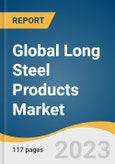The global long steel products market size is expected to reach USD 1,012.11 billion by 2030, expanding at a CAGR of 5.1% from 2024 to 2030, according to the report.. Products such as rebars and wire rodsare of vital importance in today’s world with their growing emphasis in the building and construction industry.
Based on product, the market is segmented into rebars, wire rods, sections, and tubes, of which rebars are extensively used in the construction of infrastructure and buildings. Wire rods are manufactured by drawing hot metals through shafts to develop wires with reduced diameters. Wire rods represent the most ductile form owing to their high ductility and easy availability in different diameters. They are widely used in construction and fencing applications which is positively impacting their growth.
Based on region, Asia Pacific is one of the leading markets in the world. The growth is attributable to China which is the largest producer and consumer of long steel products in the Asia Pacific. Other major markets in the region include Japan, South Korea, India, and Southeast Asian countries such as Indonesia, Vietnam, and Thailand. In recent years, the Asia Pacific market has faced challenges due to a global oversupply of raw materials, increased competition from other steel-producing countries, and the impact of the COVID-19 pandemic on the region's economies.
Further, various growth strategies such as new product development and capacity expansions by the market players are likely to benefit the industry growth. For instance, in February 2023, ArcelorMittal introduced a new blast oxygen furnace LD (Linz-Donawitz) converter in Bosnia with a capacity of 125 tons. This converter has been supplied by Primetals Technologies. Thus, this investment ramps up the production and processing of steel into billets, bars, blooms, and ingots.
Based on product, the market is segmented into rebars, wire rods, sections, and tubes, of which rebars are extensively used in the construction of infrastructure and buildings. Wire rods are manufactured by drawing hot metals through shafts to develop wires with reduced diameters. Wire rods represent the most ductile form owing to their high ductility and easy availability in different diameters. They are widely used in construction and fencing applications which is positively impacting their growth.
Based on region, Asia Pacific is one of the leading markets in the world. The growth is attributable to China which is the largest producer and consumer of long steel products in the Asia Pacific. Other major markets in the region include Japan, South Korea, India, and Southeast Asian countries such as Indonesia, Vietnam, and Thailand. In recent years, the Asia Pacific market has faced challenges due to a global oversupply of raw materials, increased competition from other steel-producing countries, and the impact of the COVID-19 pandemic on the region's economies.
Further, various growth strategies such as new product development and capacity expansions by the market players are likely to benefit the industry growth. For instance, in February 2023, ArcelorMittal introduced a new blast oxygen furnace LD (Linz-Donawitz) converter in Bosnia with a capacity of 125 tons. This converter has been supplied by Primetals Technologies. Thus, this investment ramps up the production and processing of steel into billets, bars, blooms, and ingots.
Long Steel Products Market Report Highlights
- Based on product, rebars held a revenue share of more than 34.0% in 2023 of the global market. Rebars are embedded in the concrete or used along with it so that the concrete can withstand the compressive forces in the structure and sustain against the tensile forces formed in the structure. The demand for rebars is expected to propel in developing nations owing to the growing construction activities
- In terms of revenue, wire rods is anticipated to register a CAGR of 5.9% across the forecast period owing to their rising use in the automotive industry
- Asia Pacific accounted for the highest share of over 66.0% in 2023, in terms of revenue, and this trend is anticipated to continue over the forecast period. As the region is characterized by a growing population and surging housing requirements, countries such as China and India, are witnessing an increasing number of residential construction projects. This is expected to result in significant product demand in the Asia Pacific in the coming years
- The market is characterized by intense competition. Various of players are entering into long term supply contracts with end-users. ArcelorMittal, Emirates Steel Arkan and Emirates Rebar Limited are among the leading players of the market in the world
Table of Contents
Chapter 1. Methodology and Scope
Chapter 2. Executive Summary
Chapter 3. Market Variables, Trends & Scope
Chapter 4. Long Steel Products Market: Product Estimates & Trend Analysis
Chapter 5. Long Steel Products Market: End-use Estimates & Trend Analysis
Chapter 6. Long Steel Products Market: Regional Estimates & Trend Analysis
Chapter 7. Competitive Analysis
List of Tables
List of Figures
Companies Profiled
- Emirates Steel Arkan
- Al-Rasheed Steel
- Arabian Gulf Steel Industries (AGCI)
- ArcelorMittal
- Emirates Rebar Limited
- Hamriyah Steel
- Jindal Shadeed Steel
- Rajhi Steel Industries
- RAK Steel
- Star International Steel
- Union Iron and Steel
- United Gulf Steel
Methodology

LOADING...
Table Information
| Report Attribute | Details |
|---|---|
| No. of Pages | 117 |
| Published | November 2023 |
| Forecast Period | 2023 - 2030 |
| Estimated Market Value ( USD | $ 705.53 Billion |
| Forecasted Market Value ( USD | $ 1012.11 Billion |
| Compound Annual Growth Rate | 5.1% |
| Regions Covered | Global |
| No. of Companies Mentioned | 12 |









